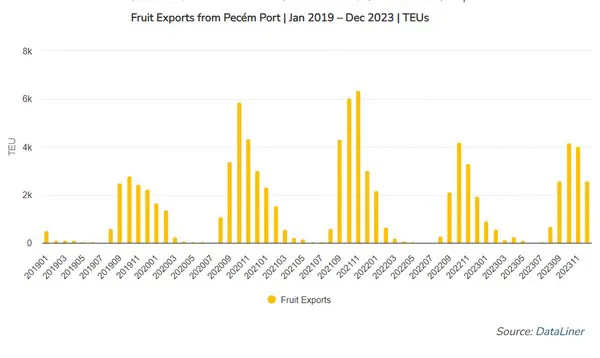Ceará state aims to expand the area certified as free from fruit flies, which currently covers 11 cities in the Jaguaribana region, near the border with Rio Grande do Norte. The state’s main goal is to further boost fruit exports, which reached a record volume last year, and a commercial value of around US$1.3 billion.
At the Port of Pecém alone, over 200,000 tonnes were exported in 2023, up 14% from a year prior.

Having as many cities as possible certified as free of fruit flies serves the purpose of gaining, consolidating, or regaining markets, explained Sílvio Carlos Ribeiro, Executive Secretary of Agribusiness at the Secretariat of Economic Development (SDE).
“We can expand the area to various municipalities in Ceará because, for example, the United States is very serious about avoiding this pest,” said the executive.
The US market, by the way, is one of the main focuses of Ceará’s fruit producers, according to the secretary. “In the past, we kept a solid export flow [to North America], and due to the unfavorable taxation in the United States, this volume decreased and the European market became more attractive. Still, now we are starting to think about the United States again, which has been widely discussed,” he said. “In recent years, Ceará has started to pay attention to the Middle East, which has a very interesting consumer market. We also began to target other parts of Asia, and then China asked for more fruits,” added the Executive Secretary of Agribusiness at the SDE. “Germany, for example, is looking for sustainably-produced fruits that have an ESG footprint. Thus, we are talking to German institutions to work with producers from Ceará,” added Sílvio Carlos Ribeiro.
The institutional director of the Brazilian Association of Fruit Exporters (Abrafrutas), Luiz Roberto Barcelos, also emphasized the importance of establishing an area free from fruit flies. “Many nations want to be sure that when they purchase Brazilian fruits, there will be no pest-carrying larvae present. Thus, we’ve been investing in pest-free areas through phytosanitary barriers and monitoring,” he said.
Overview of Fruit Farming in Ceará
Fruit Exports:
- 2023 – 200,856 tons
- 2022 – 176,957 tons
- Variation: Increase of 14%
Main products:
- Fresh melon, watermelon, and papaya: 96,988 tons (Increase of 4%)
- Dates, figs, pineapples, avocados, guavas, mangoes, and mangosteens, fresh or dried: 68,670 tons (Increase of 14%)
- Fresh or dried grapes: 26,784 tons (Increase of 59%)
- Fresh or dried coconut, Brazil nuts, and cashews: 6,423 tons (Increase of 48%)
- Fresh or dried bananas: 1,022 tons (Increase of 449%)
Source: datamarnews.com
